Synthesis Of High Pass,low Pass, Band Pass And Band Rejected Filter?
A pure notch or ring cease filter (also called band pass up filter) works by creating a Voltage Standing Wave Ratio (VSWR) resonance over a narrow bandwidth. This creates near total reflection over that bandwidth, while having very trivial reflection in the surrounding pass bands. By the nature of their creation, these notch filters are typically narrow band. Bandwidth comes linearly with added resonators, increasing size and loss.
An alternative approach to band stop cosmos is to separately design a pair of high pass and depression laissez passer filters with overlapping rejection bands in the stop ring of interest. These two filters tin and so be continued in parallel with a pair of Tee-junction elements.
Tee-junctions are a kind of ability divider/combiner used in diplexers and multiplexers to separate the electrical paths of the different laissez passer bands. The combined response is a summation of the high pass and depression pass filter responses and results in a band stop filter that can exist tuned in frequency at either -3dB passband point with piffling impact on the other passband. This filter can also exist tuned for bandwidth without the addition of more poles to the high pass and low pass filter components.

Example Filter
A moderate specification was called as a terminate filter in order to demonstrate the high pass/low pass parallel method. This specification is shown in the table below.
| Band End Spec | |||
|---|---|---|---|
| Spec | Freq | Parameter | Level (dB) |
| Passband one | 10MHz - ii.5GHz | S21 | >-1 |
| Stopband | 3.25GHz-iv.25GHz | S21 | <-xiii |
| Passband two | 5GHz - 9GHz | S21 | >-i |
High Laissez passer Component
A v section high pass filter was designed and tuned in Microwave Office to judge the upper half of the band stop spec. The filter was simulated and tuned as an air dielectric stripline with broadside coupling capacitance at the input and output and between the 2 shorted stub resonators. The insertion loss of the tuned loftier pass filter with limit lines for the band terminate specs is shown below in Figure 1.
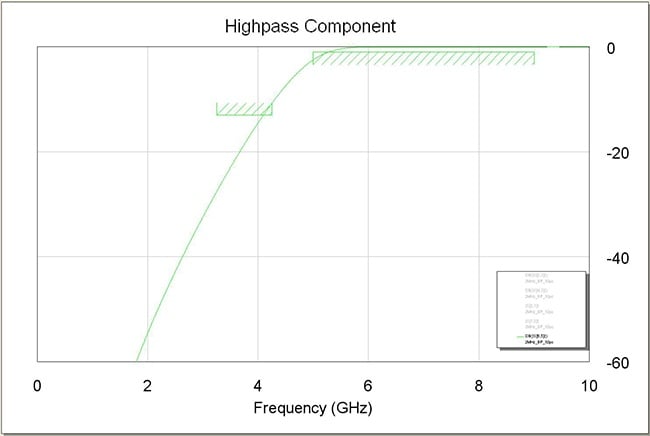
Figure 1: Insertion Loss of Tuned High Pass Filter.
Low pass Component
Like the high pass finish, a v section low pass filter was designed in air dielectric stripline with ii open-circuit stub resonators separated by three matched transmission line sections. The low pass filter response is shown in Figure 2, forth with the lower one-half of the ring finish spec.
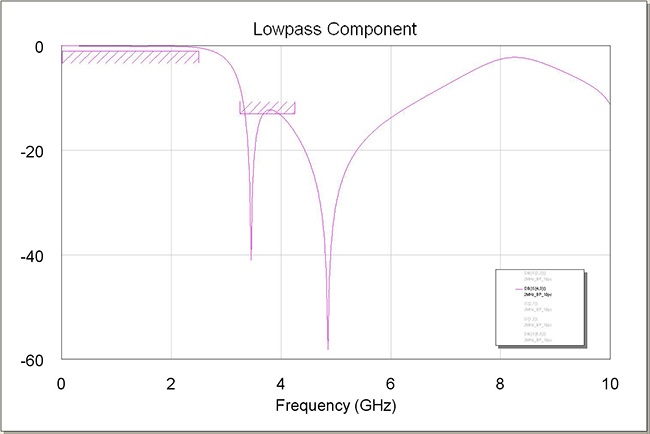
Figure two: Depression Pass Filter Response
Band stop Filter
The high pass and low pass components were continued in parallel by using tee-junctions on both sides of the filters. A tee-junction is a type of divider/combiner typically used in diplexers and multiplexers as a junction between the low laissez passer and high pass arms. The resulting circuit required impedance tuning on both filters every bit well as an area nearly the tee-junction to reach the high reflection stop band. Figure three shows the imitation insertion loss plot vs. the original ring finish filter specs.

Effigy 3: Band Finish Filter Simulated Insertion Loss
Tuning the LPF Over Frequency
To demonstrate the flexibility of tuning a band stop of this kind for frequency, a spec with the same high pass cutoff frequency, but a lower depression laissez passer cutoff frequency was selected, making a broader terminate band. This is shown in the table below.
| Med. BW Band Finish Spec | |||
|---|---|---|---|
| Spec | Freq | Parameter | Level (dB) |
| Passband 1 | 10MHz - 2.0GHz | S21 | >-ane |
| Stopband | 2.75GHz - 4.0GHz | S21 | <-13 |
| Passband 2 | 5GHz - 9GHz | S21 | >-i |
The new low laissez passer was but scaled linearly with respect to starting and target cutoff frequencies. Resonator lengths and transmission line lengths were scaled by a factor of 1.two:1 and retuned, while the manual line and resonator widths were not inverse as the same characteristic impedance was desired. The resulting high laissez passer filter response is shown in Figure 4.
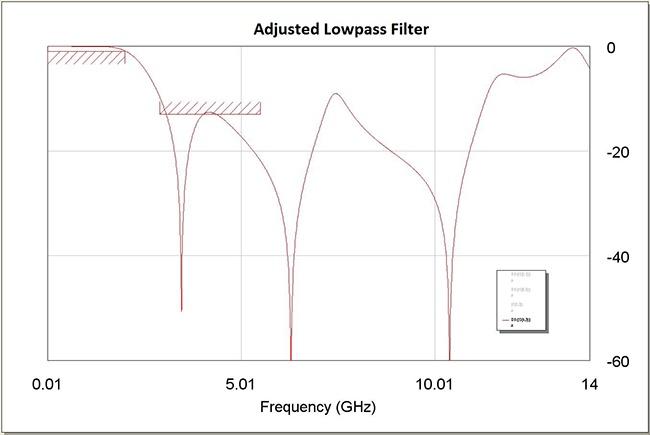
Figure 4: High Pass Filter Response
This filter was then stitched back into the bandstop filter as above, with some modest tuning for the loftier reflection stop band. The response of this new filter is shown in Figure five.
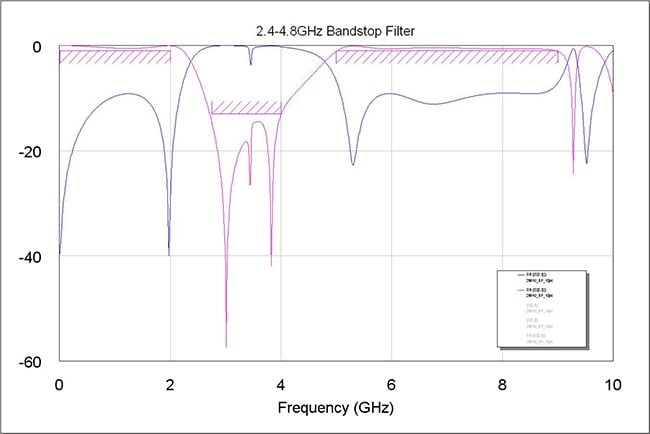
Effigy v: High Laissez passer Filter Response After Tuning
Tuning the HPF over Frequency
Just with the low pass filter above, the loftier pass filter can as well be tuned over frequency to change the centre band stop frequency and the ring stop bandwidth. To demonstrate this, a new spec was created with the same low-end specs as the second broader bandstop above and a higher high pass cutoff frequency, resulting in an even broader stop ring. This spec is shown in the table below.
| Wide BW Bandstop Spec | |||
|---|---|---|---|
| Spec | Freq | Parameter | Level (dB) |
| Passband 1 | 10MHz - 2.0GHz | S21 | >-1 |
| Stopband | ii.9GHz - 5.5GHz | S21 | <-13 |
| Passband 2 | six.7GHz - 10 GHz | S21 | >-one |
The high pass filter was tuned similarly to the low pass, scaling the shorted stub resonators by a factor of 0.75:1, likewise as the lengths of the couplers connecting them. The couplers had to be farther tuned to recoup for the reduced coupling values of shortening their lengths. The resulting high pass filter response is shown in Figure half-dozen.
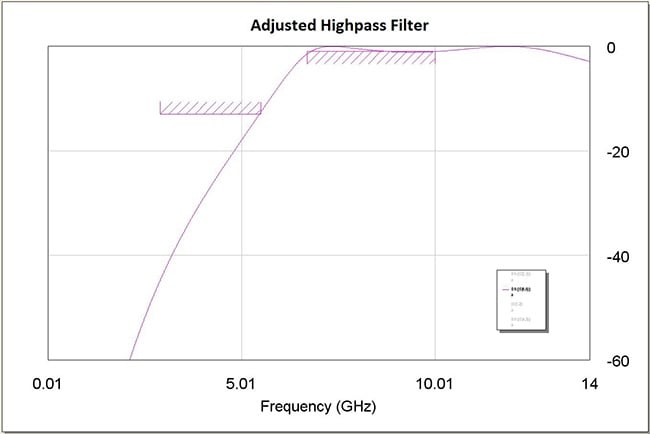
Figure 6: High Pass Filter Response After Coupler Tuning
The new high laissez passer filter was and then added back to the band stop model to create a band stop that is wider ring both at the high pass and low laissez passer ends than the original. The resulting model was tuned and the response is shown in Figure seven.
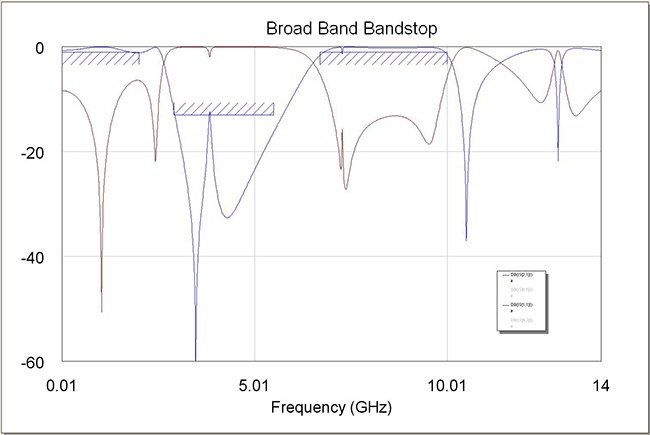
Figure vii: Wide Broad Brand Bandstop Filter Response

Summary
For challenging band cease applications, specifically those with a broad stopband or those that may crave tuning in frequency of 1 band border without much impact on the other, a parallel implementation of split up high pass and low pass filters may exist a good solution. This solution allows the ring finish edges to be implemented and tuned independently before existence joined in parallel. Another benefit of the implementation is that broad band bandstop can exist achieved without adding a loss and space-prohibitive number of resonators to the pattern.
Synthesis Of High Pass,low Pass, Band Pass And Band Rejected Filter?,
Source: https://blog.epectec.com/creating-low-pass-high-pass-band-stop-filter-designs
Posted by: shiressucarty.blogspot.com


0 Response to "Synthesis Of High Pass,low Pass, Band Pass And Band Rejected Filter?"
Post a Comment